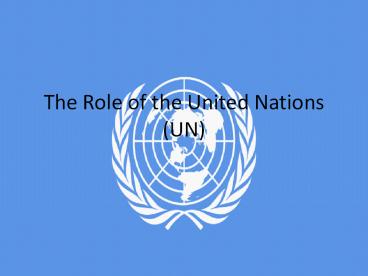The%20Role%20of%20the%20United%20Nations%20(UN) - PowerPoint PPT Presentation
Title:
The%20Role%20of%20the%20United%20Nations%20(UN)
Description:
The Role of the United Nations (UN) United Nations (UN) Established in 1945, it has 192 member nations. The UN is not an international government and it does not make ... – PowerPoint PPT presentation
Number of Views:154
Avg rating:3.0/5.0
Title: The%20Role%20of%20the%20United%20Nations%20(UN)
1
The Role of the United Nations (UN)
2
United Nations (UN)
- Established in 1945, it has 192 member nations.
- The UN is not an international government and it
does not make laws. - Countries sign to become a member of the UN. They
are required to accept the obligations of the UN
Charter. - It is actually a forum where all member states
have the opportunity to voice their opinions and
where they can vote on global issues that affect
the populations of the world. - It provides an opportunity to help resolve
international conflicts and formulate policies on
matters that effect all people.
3
Globalissues addressed by the UN include
- Agriculture
- Children
- climate change
- culture
- education,
- Environment
- family, human rights,
- international law,
- least developed countries, population, refugees,
- social development and sustainable development.
4
(No Transcript)
5
UNs four key areas ofaction
- International peace and security
- Human rights
- Humanitarian action
- Economic and social development.
6
International peace and security
- One of the fundamental aims of the UN is to
uphold international peace and security. Its work
in this area falls into four stages - Conflict prevention mediating between countries
and helping to prevent tension from escalating
into war - Peace-making helping resolve conflicts that have
erupted - Peace-keeping and enforcement helping countries
torn by conflict generate the conditions for
permanent peace, and - Peace-building helping with recovery,
reconstruction and development. - Read pg 358 activity 10.2B
7
(No Transcript)
8
How does the UN works for peace and why it is
important to the health and development of
individuals.
9
Human rights
- According to the UN, human rights are inherent
to all human beings, whatever our nationality,
place of residence, sex, national or ethnic
origin, colour, religion, language, or any other
status. We are all equally entitled to our human
rights without discrimination. These rights are
all interrelated, interdependent and indivisible.
10
Universal Declaration of Human Rights, Proclaimed
by the UN General Assembly in 1948.
- They include
- The right to life, liberty and nationality
- Freedom of thought, conscience and religion
- The right to work and to be educated
- The right to food and housing
- The right to participate in government
11
(No Transcript)
12
Humanitarian action
- Humanitarian disasters can be caused be flood,
drought, earthquake or conflict, a humanitarian
disaster means lost lives, displaced populations,
communities incapable of sustaining themselves
and great suffering. - By the end of 2006, 12.8 million people had been
displaced within their own countries, and 9
million had become refugees by fleeing across
international borders - Natural disasters, mostly weather-related, affect
more than 200 million people each year
13
The UN responds to disasters in 2 ways
- Initially it provides immediate relief to the
victims such as food, shelter, medicines and
logistical support. (eg evacuation, restoring of
basic amenities.) - Secondly the UN seeks more effective strategies
to prevent these types of situations occurring
again. - Read pg 361 complete activity 10.2 D and E
14
Economic and social development
- The UN works towards economic and social goals by
helping countries to formulate policies, set
standards and through economic aid. There are a
number of bodies and programs that aim to enhance
the development of countries and their people.
Some examples of these are - The Millennium Development Goals to promote
sustainable human development - UNICEF, which is the main organisation working
towards the long term survival, protection and
development of children - The UN settlements program, which assists people
living in health-threatening housing conditions. - Pg 365 Activity 10.2F

